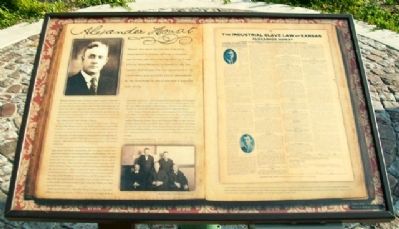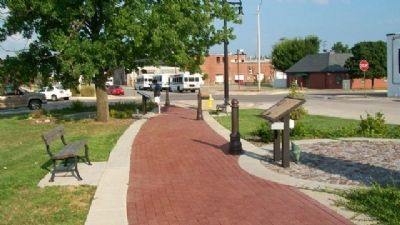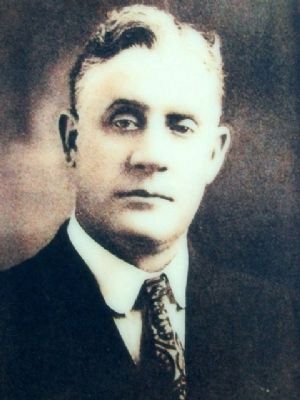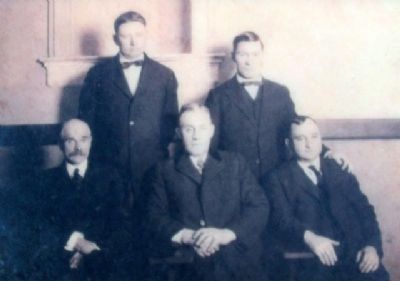Pittsburg in Crawford County, Kansas — The American Midwest (Upper Plains)
Alexander Howat
— Miners’ Memorial at Immigrant Park —
Among the many significant European immigrants in Kansas history is Alexander Howat, President of District 14 of the United Mine Workers of America. He was chiefly responsible for the organization of a powerful and militant union membership in the territory of the Cherokee-Crawford coal fields.
Alexander McWhirter Howat was born in Glasgow, Scotland, on September 10, 1876. At the age of three he emigrated with his parents to Troy, New York, moving from there to Braidwood, Illinois. Howat attended public schools until the age of ten when he took a job as a trapper boy in the Illinois coal mines. In 1889 the Howat family moved to Crawford County, Kansas, where Alexander again attended public schools for several years then worked in the mines until he was twenty-two. In 1898 Howat took employment on a cattle boat to Scotland. He worked in the mines of his native country for a year before returning to America.
When he returned to the Kansas coal fields, Howat became an active member of the United Mine Workers of America. In 1902 he was elected as a board member for District 14. He became its vice-president in 1904 and in 1906 was elevated to president. In Howat, the Kansas coal miners found a labor leader who unified the diverse ethnic groups of southeast Kansas into a strong economic and political force. In 1918, with President Woodrow Wilson's approval, Howat served on a labor mission to Europe to help build up the morale of the working class during a critical period of World War I.
In 1919, during a general coal strike, Alexander Howat and District 14 stood firm despite pressure from Kansas Governor Henry Allen. In response, Governor Allen implemented the Kansas Court of Industrial Relations the following year. This court was advanced as a national model for dealing with labor disputes. It made all disputes between labor and management a matter of arbitration, taking away the right of unions to call a strike. Howat was bitterly opposed to the Industrial Court and set about to discredit it. Doing so meant he would be heavily fined and forced to serve three years' imprisonment. District 14 pledged full support to their president when he called for new strikes in defiance of the law. John L. Lewis, the international president of the United Mine Workers ordered Howat to call off his strike. He refused and in 1921 was expelled from the Union. John L. Lewis, sensing a viable opponent in Howat for the international presidency of the United Mine Workers, was largely responsible for Howat's expulsion.
Howat was reinstated to the United Mine Workers of America in 1924 and in 1928 was re-elected to the presidency of District 14. In 1930 an insurgent group of miners broke with the John
L. Lewis union and elected Howat president of the Reorganized Mine Workers Union. Lewis again expelled Howat from the United Mine Workers. When the courts of Illinois dissolved the re-organized group in 1931, the power of Howat was destroyed for he was never able to regain membership into the Union Mine Workers.
In 1931 Alexander Howat was appointed a contract investigator by the U.S. Secretary of Labor, William N. Doak. John L. Lewis used his influence to have Howat removed from his new position and from his subsequent position with the State of Kansas as a Port of Entry inspector. Defeated, but unbroken, Howat then became the publisher of a labor newspaper called the Independent News. He ended his days as a street sweeper for the city of Pittsburg. For twelve years prior to his death, Howat was the president of the Pittsburg Local Union No. 312 of the Pittsburg Building and Common Laborers. Howat's death on December 10, 1945, constituted the passing of one of the most loyal and faithful friends American labor ever had.
Written by Randy Roberts, Pittsburg State University.
For more information on Alexander Howat please refer to Special Collections at Pittsburg State University Axe Library
Erected 2008 by Miners' Memorial.
Topics and series. This historical marker is listed in these topic lists: Civil Rights • Government & Politics • Industry & Commerce • Labor Unions. In addition, it is included in the Former U.S. Presidents: #28 Woodrow Wilson series list. A significant historical month for this entry is September 1903.
Location. 37° 24.552′ N, 94° 42.401′ W. Marker is in Pittsburg, Kansas, in Crawford County. Marker is on 2nd Street near Pine Street, on the right when traveling west. Marker is at the Miners' Memorial. Touch for map. Marker is in this post office area: Pittsburg KS 66762, United States of America. Touch for directions.
Other nearby markers. At least 8 other markers are within walking distance of this marker. The Amazon Army (a few steps from this marker); Wilkinson Coal Company (a few steps from this marker); The Weir-Pittsburg Coal Field in Cherokee County (a few steps from this marker); Frontenac, Kansas (within shouting distance of this marker); Southeast Kansas Coal Mining (within shouting distance of this marker); The Weir - Pittsburg Coalfield (within shouting distance of this marker); Immigrant Park (within shouting distance of this marker); The Freedom Tree (approx. ¼ mile away). Touch for a list and map of all markers in Pittsburg.
Also see . . .
1. Miners' Memorial.
(Submitted on September 13, 2010, by William Fischer, Jr. of Scranton, Pennsylvania.)
2. 1921 Article on Howat. (Submitted on September 13, 2010, by William Fischer, Jr. of Scranton, Pennsylvania.)
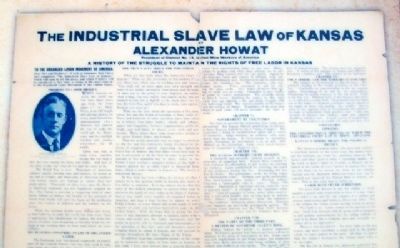
circa early1900s
5. Broadside on Howat Marker
[Caption reads] Alexander Howat used this broadside to advertise his history of the Kansas Industrial Court experience. No copy of his manuscript or book has ever been located. Howat did not believe the Kansas Industrial Court Law was unconstitutional or that its impact was going to be limited to a single state. Kansas, Howat warned, was being used by government and by management as a test site in their attempt to weaken organized labor throughout the nation by denying labor the right to strike.
Credits. This page was last revised on December 7, 2021. It was originally submitted on September 12, 2010, by William Fischer, Jr. of Scranton, Pennsylvania. This page has been viewed 1,801 times since then and 40 times this year. Photos: 1, 2, 3, 4, 5. submitted on September 13, 2010, by William Fischer, Jr. of Scranton, Pennsylvania.
